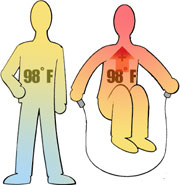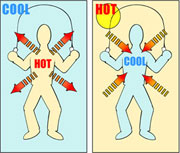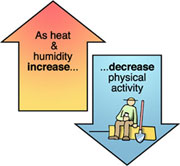In recent years, there have been several well-documented cases of highly conditioned athletes dying unexpectedly while exercising in the heat. Understanding what causes the body to overheat can help you prevent a heat-related illness.
What causes the body to overheat when exercising in hot environments?
 At rest, the body is able to balance heat production and heat loss so that its temperature remains around 98 degrees Fahrenheit. However, body temperature begins to rise during exercise as it converts the chemical energy from food into the mechanical energy necessary for movement. The degree of increase is directly proportional to the intensity of the exercise bout. In other words, the harder you are exercising, the higher your body temperature becomes. When you exercise in average indoor or outdoor conditions, the body is usually able to adjust to the increase in body temperature. However, during hot conditions, the body loses its ability to radiate heat from its surface. In fact, when the air temperature exceeds body temperature (above 98 F), the body actually gains heat from the environment. In this case, evaporation, or the conversion of a liquid (sweat) to a gas, becomes the body's only legitimate defense against overheating. Millions of sweat glands on the surface of the skin secrete large amounts of liquid, which when evaporated, help to cool the skin, which in turn cools the blood and ultimately the body. Serious problems can arise because high air temperatures stimulate excessively large amounts of sweat production, which can lead to a dehydrated state. Dehydration leads to higher body temperature. Severely dehydrated individuals can suffer circulatory collapse and death. Heat illness is divided into three incremental stages (heat cramps, heat exhaustion and heat stroke), which, if not dealt with immediately, can lead to medical complications and even death.
At rest, the body is able to balance heat production and heat loss so that its temperature remains around 98 degrees Fahrenheit. However, body temperature begins to rise during exercise as it converts the chemical energy from food into the mechanical energy necessary for movement. The degree of increase is directly proportional to the intensity of the exercise bout. In other words, the harder you are exercising, the higher your body temperature becomes. When you exercise in average indoor or outdoor conditions, the body is usually able to adjust to the increase in body temperature. However, during hot conditions, the body loses its ability to radiate heat from its surface. In fact, when the air temperature exceeds body temperature (above 98 F), the body actually gains heat from the environment. In this case, evaporation, or the conversion of a liquid (sweat) to a gas, becomes the body's only legitimate defense against overheating. Millions of sweat glands on the surface of the skin secrete large amounts of liquid, which when evaporated, help to cool the skin, which in turn cools the blood and ultimately the body. Serious problems can arise because high air temperatures stimulate excessively large amounts of sweat production, which can lead to a dehydrated state. Dehydration leads to higher body temperature. Severely dehydrated individuals can suffer circulatory collapse and death. Heat illness is divided into three incremental stages (heat cramps, heat exhaustion and heat stroke), which, if not dealt with immediately, can lead to medical complications and even death.
What are heat cramps and what should I do to prevent them?
Heat cramps are involuntary muscle spasms that can occur during or following physical exertion. Generally, heat cramps result from an electrolyte imbalance due to excessive loss of salts. Direct pressure, massage and simple stretching of the cramped muscle should help alleviate the cramping. Heat cramps are the first sign of heat illness and are a signal to drink more water and/or decrease the intensity of physical exertion.
What is heat exhaustion and what prevents it?
Heat exhaustion is a more serious state of heat illness that usually occurs when a person has not become accustomed to exercising in the heat. Heat exhaustion especially can occur in someone who is not used to exercising in the heat if he or she has not consumed enough water before or during a workout. Heat exhaustion may or may not include collapse with or without consciousness. Symptoms include excessive sweating, cold, clammy skin, normal or slightly elevated body temperature, paleness, dizziness, weak and rapid pulse, shallow breathing, nausea and headache. Anyone experiencing these symptoms should immediately stop exercising and get into the shade, or better yet, get inside an air-conditioned building. An abundant amount of fluid should be consumed. If the situation seems severe enough, elevate the feet and seek medical help.
What is heat stroke and how can I prevent it?
The most advanced stage of heat illness is called heat stroke. In simple terms, heat stroke is a breakdown of the cooling mechanisms of the body, induced by high body temperature. Someone who is experiencing heat stroke may stop sweating altogether and the skin will appear dry and hot. The pulse is usually strong but rapid. The person may have labored and difficult breathing. Body temperature can exceed 106 F. Heat stroke is an emergency that requires immediate medical attention! Transport the person to the hospital as quickly as possible, ideally in wet sheets. In the meantime, cool the person by any means possible (hose down, apply ice packs, submerge body completely in cold or icy water). Remove as much clothing as possible and treat for shock by elevating the feet slightly.
My friends tell me that humidity causes heat-related illnesses, and I say it is the temperature. Which of us is right?
 You are both correct. During hot conditions, the body loses its ability to radiate heat from its surface. Air temperature is a key factor in determining your risk of overheating, but the humidity level, or the air's water content, is equally important. Several deaths of football players have occurred with air temperatures below 75 F at 95 percent humidity levels. High humidity levels reduce the evaporation of sweat from the skin. Even though it may seem that you are sweating a lot when it is humid, the sweat is mostly rolling off the skin and is not really contributing much to the cooling process. Sweat alone does not cool the body. It is the evaporation of sweat that cools the body. The combination of high air temperatures and high humidity levels increases the risk of heat illness.
You are both correct. During hot conditions, the body loses its ability to radiate heat from its surface. Air temperature is a key factor in determining your risk of overheating, but the humidity level, or the air's water content, is equally important. Several deaths of football players have occurred with air temperatures below 75 F at 95 percent humidity levels. High humidity levels reduce the evaporation of sweat from the skin. Even though it may seem that you are sweating a lot when it is humid, the sweat is mostly rolling off the skin and is not really contributing much to the cooling process. Sweat alone does not cool the body. It is the evaporation of sweat that cools the body. The combination of high air temperatures and high humidity levels increases the risk of heat illness.
How do I measure my heart rate at rest and during exercise?
Measuring heart rate is often referred to as palpation. You can master it easily with a little practice.
- At rest (sitting or lying down), take your first two fingers and locate the radial pulse. This artery is found on the thumb side of your wrist on the underside of the arm. Use only the first two fingers; not the thumb, which can have its own pulse. Also, don’t press too hard or you could block the artery and won’t feel any pulse.
- After finding the pulse, look at your watch (or use a stopwatch) and count the number of beats in one minute. This number represents your minute heart rate or your resting heartbeat. You could also just count the number of beats in 30 seconds and multiply by two. The best time to get a true resting heartbeat is immediately upon waking up in the morning, before getting out of bed.
During exercise, you may have to stop what you are doing to find your pulse. However, do your best to locate it without stopping. Once you locate the pulse, count the number of beats in 10 seconds and multiply that number by six to get your exercise heart rate. For example, if you count 20 beats in 10 seconds, your exercise heart rate is 120 beats per minute (20 × 6 = 120). Speed up or slow down, based on your target heart rate zone.
How can I determine my target heart rate zone?
- Determine your maximum heart rate (MHR) by using this formula: 207 - (0.7 × age)
- Multiply your MHR by 0.55 = lower end of the target heart rate zone.
- Multiply your MHR by 0.90 = upper end of the target heart rate zone.
These two numbers represent your target heart rate zone. You should strive to stay between these numbers during your workout. Here is an example calculation for a 30-year-old woman:
- 207 - (0.7 × 30) = MHR of 186
- 186 × 0.55 = 102 beats per minute
- 186 × 0.90 = 167 beats per minute
Target heart rate zone = 102 to 167 beats per minute
Avoiding heat illness
The most effective way to manage heat illness is to prevent it. The following guidelines offer simple steps for the prevention of heat-related illness:
- Recognize that any form of physical exertion, not just exercise, can result in heat-related problems.
- Recognize that unfit individuals are more likely to suffer a heat-related illness.
- Recognize when temperature or humidity conditions might require you to decrease the intensity of your physical activity.
- Before strenuous physical activity, drink plenty of water and other fluids.
- Drink more fluids during the activity than your thirst dictates. It is difficult to drink too much.
- Drink plenty of fluids after your workout.
 As outside temperatures and humidity increase, gradually decrease your physical activity in the short term before increasing your activity back to the previous level over seven to 10 days. In other words, take it easy the first several times you are exposed to a hot environment before increasing your intensity level.
As outside temperatures and humidity increase, gradually decrease your physical activity in the short term before increasing your activity back to the previous level over seven to 10 days. In other words, take it easy the first several times you are exposed to a hot environment before increasing your intensity level.- Monitor your heart rate to make sure you are in your target heart rate zone.
- Monitor your weight before and after physical activity. If you have lost more than 3 percent of your total body weight prior to the next workout, skip the workout entirely. For example, 3 percent of 120 pounds is about 3.5 pounds, and 3 percent of 175 pounds is about 5 pounds.
- Consume adequate amounts of carbohydrates, especially fruits and vegetables, because they contain large amounts of water.
- Expose as much skin as possible to increase cooling through sweat evaporation. Don't forget to wear sunblock.
- Plan your physical activities for the cooler parts of the day.
- Recognize the early warning signs of heat illness, such as heat cramps, excessive sweating, cold, clammy skin, normal or slightly elevated body temperature, paleness, dizziness, weak and rapid pulse, shallow breathing, nausea and headache.